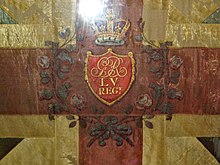55th Regiment of Foot
| 55th (Westmorland) Regiment of Foot | |
|---|---|

Detail from 1786 Regimental colour of the 55th (Westmorland) Regiment.
|
|
| Active | 1755–1881 |
| Country |
|
| Branch |
|
| Role | Infantry |
| Size | One battalion |
| Garrison/HQ | Carlisle Castle |
| Nickname(s) | "The Two Fives" |
| Engagements |
French and Indian War Pontiac's War American Revolutionary War French Revolutionary Wars Napoleonic Wars Fifth Xhosa War Coorg War First Opium War Crimean War Bhutan War |
| Commanders | |
| Notable commanders |
George Augustus, Lord Howe |
The 55th Regiment of Foot was a British Army infantry regiment raised in 1755. After 1782 it had a county designation added, becoming known as the 55th (Westmorland) Regiment of Foot. It was amalgamated with the 34th (Cumberland) Regiment of Foot to form the Border Regiment in 1881.
The regiment was raised in Stirling by Colonel George Perry as the 57th Regiment of Foot in 1755 for service in the Seven Years' War. It was re-ranked as the 55th Regiment of Foot, following the disbandment of the existing 50th and 51st regiments, in 1756.
The regiment embarked for North America for service in the French and Indian War and arrived in Nova Scotia on 8 July 1757 with the objective of taking part in the abandoned attack on the Fortress of Louisbourg. Following the death of Colonel Perry, Lord George Augustus Viscount Howe was appointed Colonel of the regiment in September 1757. After the regiment arrived in Albany, New York in November 1757, Howe accompanied Major Robert Rogers, commander of His Majesty's Independent Companies of Rangers on a scout, to learn the art of "bush fighting." Howe's willingness to learn from the American rangers and his interaction with subordinates won him the respect of both colonist and British redcoat being described as the "Idol of the army." In the spring of 1758, Howe began to train and accoutre the men in the regiment more like rangers to better adapt them to warfare in America. He was killed in a skirmish the day before the Battle of Carillon in July 1758.
After Howe's death John Prideaux was appointed commander of the regiment. In an unfortunate accident Prideaux was killed by the blast of a cohorn while walking through the entrenchments during the Battle of Fort Niagara in July 1759. The regiment, as part of General Jeffery Amherst's army, participated in the Battle of Ticonderoga and the capture of Fort Crown Point later that month.
...
Wikipedia
